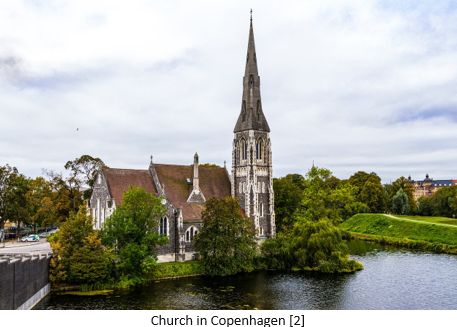Danish Research Part 4 : Helpful Websites and Resources
 30
30Apr

The key to any genealogical research is knowing the right places to look. Especially when breaking into foreign language genealogy, it can be difficult to know if you are looking at the right website or whether you might be missing a useful website. Here is a general overview of the most useful Danish genealogy websites. This list is not intended to be totally comprehensive, but cover the big ones and some of the author’s favorite websites. Many of these websites are in Danish and therefore require some knowledge of Danish to navigate. The word English has been included for websites that are either all in English or have some English content. Note that while the website might be in English, the records and descriptions often are not.
Danish Research Part 4
FamilySearch Wiki: Denmark Genealogy
(https://www.familysearch.org/wiki/en/Denmark_Genealogy)
The first place to stop for Danish research is the FamilySearch wiki. Many of the websites listed below are actually mentioned in the wiki with direct links to the website. Two of the best tools on the wiki for Denmark are the parish maps and the Danish to English word list.
The parish map tool begins with the main map of Denmark and its historical counties (the county boundaries were changed in 1970). Using the tool, you can select a county and see a map of all the parishes inside that county. They are even grouped by their judicial district or herred. These maps are critical in Danish research. They can be used to find the location of your ancestors’ parishes, learning which parishes were nearby, and knowing what the judicial district was called for your ancestors’ parishes.
The Danish to English word list is fairly self explanatory. Kind contributors to the wiki have compiled a large list of important Danish terms used in genealogical records. This includes titles, occupations, and more. And be sure not to miss the hidden word list for Denmark Probate Records which is invaluable for deciphering a Danish estate inventory.
Arkivalieronline (English)
(https://www.sa.dk/en/services/arkivalieronline/archives-online/)
While several of the major genealogical websites: Ancestry, FamilySearch, MyHeritage have great collections for basic Denmark records, nothing beats the National Archives’ digital collections of church, census, military, probate, and property records. These collections, while not indexed, are the most complete collection of these types of records anywhere on the internet.

DanishFamilySearch.dk (English)
This website is dedicated to making Danish genealogy searchable. They have made many of the Danish church books and censuses searchable with standardized names. They have also worked on school protocols and military conscription rolls. As you browse to a specific county and parish, you can see how much of the church books have been indexed as a percentage.
Collections of the Major Companies (English)
MyHeritage (https://www.myheritage.com/)
While there are Danish records available at most of the major genealogy websites, Myheritage and
Ancestry deserve special mention. MyHeritage has digitized and has indexes for all of the available Denmark censuses from 1787 to 1940. This is one of the best websites to search the censuses.
Ancestry (https://www.ancestry.com/)
Ancestry recently partnered with the Danish National Archives to publish an index of church books across the country. The index is growing, but is already becoming a comprehensive collection. In conjunction with Ancestry’s suggested records tool, this database is going to become the best place to search for Denmark church records.
Dansk Demografisk Database (https://ddd.dda.dk) (English)
The main component in this website is the census search. Many of Denmark’s censuses have been indexed and can be searched in a number of different ways. If a straightforward search does not work for you, you can search for by name, age, gender, and location in one parish and even multiple counties at a time. To see their index coverage, you can google the word “kipkort” and click on “Kildeindtastninger - DIS-Danmark” to see a spreadsheet showing which areas in the country have been indexed for which years.
Some other gems on this website include their probate indexes for certain parts of the country and their “Emigrants via Vejle” index (these collections are in Danish).
Lægdsruller.dk
While military rolls are powerful genealogical resources for tracking a man over time, they are not generally indexed and it can be quite a process to find the right set of rolls. Lægdsruller.dk has a number of different tools that make searching military rolls easier. The two most important are their main lægdsruller search which allows you to narrow down to a specific roll by a parish or city, then by selecting a year. Note that when picking a place there may be a “v. [another place name]” after the name of the place. This suggests that there might be multiple places with that name so they included the name of a nearby location. This is where looking at maps of the area and learning the names of nearby towns would be useful.
This website can also help with finding the next set of military rolls if the man ever moved. The “flyt til nyt lægd” tool helps you take the clues that may have been left on the rolls and use it to find the military rolls at the man’s new location.
DAISY Search at Rigsarkivet (https://www.sa.dk/da/)
DAISY is the archive database/catalog for the Danish National Archives. If the archives have any other digitized material, other than the normal church books, censuses, military rolls, probates, etc., then it can be found through DAISY. To search, you want to type in the name of the record-creating organization. If you are looking for parish records other than the church books, type in the name of the parish. If you are looking for court records, type in the name of the herred or local court. If you are looking for probate records, type in the name of the court, estate, diocese, or county where the probates were made.
One of the known genealogical gems are the Thingvalla passenger list records which are not preserved anywhere else. Certainly, there are many more gems to be discovered as more records are digitized by the archives.
Not only are the probate records digitized but so are many of the indexes. There are also a decent number of websites out there that have extracted the basic information of probate and copyhold records in an easily searchable format. Rather than browsing the probate records on the National Archives website, check out these websites to see if records in the area you are searching have been extracted:
- https://brejl.dk/
- https://aurelia-clemons.dk/probate.htm
- https://www.faesterogskifter.dk/default.aspx
National Library Newspapers (https://www2.statsbiblioteket.dk/mediestream/avis)
Newspapers are great for finding death notices, living relatives, and more. The National Library in Denmark has a very large collection of Danish historical newspapers and they conducted a large digitization project in the 2010s. While over 35 million pages have been digitized only about a third is available to search from home. Newspapers printed in the last 100 years can only be viewed on-site at the library and a select few other locations.

Death Notice websites
When searching for living descendants of your ancestors, newspapers are an essential resource. Many Danish families publish death notices in local newspapers which include basic information about the deceased and often at least the first names of surviving relatives. Two websites which preserve these death notices are:
-https://xn--ddsannoncer-ggb.afdoede.dk/
-https://www.dodsannoncer.dk/oversigt
Dødsregister/Death Register (https://dodsregister.dk/)
The Danske Slægtsforskere (Danish Genealogical Society) has published a death index for the country between 1943 and 1969. While some Danish church books are available to view online up until the 1960s, indexes do not typically go past the early 1900s. Therefore, this index is invaluable for finding deaths in that specific time period.
Conclusion
Half the learning curve for doing genealogy in a new area is knowing what are the best resources. Try to explore some of these websites and find your ancestors’ records. Interested in your Danish ancestry, but cannot read Danish records? Price’s genealogists are experts in these Danish websites and can help you find your family,
- Forrest
Sources:
[1] Image from https://pixabay.com/photos/children-win-success-video-game-593313/.
[2] Image from https://pixabay.com/photos/old-newspaper-newspaper-retro-sepia-350376/.
[3] Image from https://pixabay.com/photos/church-copenhagen-st-4852887/.
Have you ever done any Danish research? What was your experience like? Let us know in a comment below!
